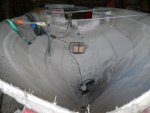Re: Bayliner Capri unintentional restoration project
Taking a step back with this post. Grinding fibreglass is a horrendous job - I've been itching every night for 2 weeks! All is removed from the hull...although there will still be yet more grinding to do with time.
I found a masonry cutting disc was very useful for slicing through the fibreglass and a 36 grit pad was best for everything else although you get through a lot of them.
I've left the upper bits for now as reference points for when I'm building the rest of the boat back up later. The centre of the hull from bow to stern was designed as basically one through drain to the bilge under the deck and under the fuel tank. I plan to seal most of this off in the rebuild. This was covered in a deep layer of paint/gel coat which I decided to grind down so that glass for the stringers would stick better...I was glad I did as I found the hull underneath to be very thin and even non-existent in places:

I will reinforce the length of the bottom of the hull and other holes made by accident - not sure how yet but I will search on iboats and find the answer I'm sure!
I have had major problems with fibreglass delamination and have taken up loads of layers of matt using my hammer and a masonry chisel. I think this all needs to be removed so that I am applying new layers to solid foundations.
I have been going round getting supplies that I need to start and my fibreglass stuff arrived today. I have bought 1/2" and 3/4" exterior grade birch ply sheets. The transom will be made of 2 bits of 3/4" stuck together which will be thicker than what was there before. The exterior transom skin seems v thin so when I'm glassing the new transom in place I was wondering about continuing the cloth across the entire width of the stern and around the corner along the hull for about a foot for added strength. What do people think of this plan? The stringers will be 2 bits of 1/2" stuck together to make them 1" wide which is a bit thicker than they were before I think. The deck will be one sheet of 1/2" to save weight but with added supports/bulkheads underneath than was there before. The previous deck was 2 layers of I think 3/4" ply which seems like enough support for a car ferry let alone a leisure boat!
The chine that the stringers run in had 1/2' lengths of wood baton in towards the bow - I presume to provide a base for the stringers. These were completely wet as well. However, right at the bow end the stringer went in a straight line up the side of the hull where as the chine obviously bends around the corner following the lines of the boat to the front. The batons were butted together and followed the chine. They would have been providing no strength themselves whatsoever but I suspect the fibreglass covering them would have. I'm not going to put the same thing back but haven't yet decided what I'm going to do.

This is the boat now - most of the grinding done and swept out. It has had one jet was so far but will need another after I have done the final bits of stringer grinding. Tomorrow I hope to get the transom cut and waterproofed. Never done any fibreglassing before so a bit worried about it but looking forward to not grinding! Also not sure how I'm going to clamp the bottom of the transom to the skin while the 'peanut butter' sets as don't really want to put any holes through it for putting a bolt through to clamp that way. Anyone have any ideas? I think this bit would be easier if it was a i/o transom.

































































